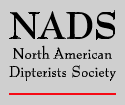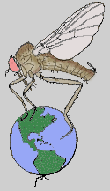
.jpg)
Home | General | "Empididae" | Dolichopodidae | CNC Types | Dolichopodidae Checklist | Dolichopodidae Higher Classification
Empidoidea Higher Classification
General Information about Empidoid Flies
The Empidoidea are a very large, diverse group of flies consisting of over 11,000 described species worldwide and about 2,100 described species in America north of Mexico. Thousands of empidoid species still remain to be described with a reasonable estimate of the total diversity in the group exceeding 20,000 species worldwide. This enormous species diversity corresponds to a very large morphological diversity for the entire group. Adult empidoid flies range in size from 1 mm to 15 mm and exhibit a wide variety of shapes and sizes. They are generally relatively slender flies that are often darkly pigmented or metallic green in colour, with hyaline, infuscate or patterned wings. Adults can generally be separated from most other groups of flies by a combination of one or more of the following features: raptorial modifications on one or more sets of legs, beak-like predatory mouthparts, shortened anal cell (cell cup) that does not come close to the wing margin, metallic green colouration combined with long legs, ventrally narrowed or divided metepisternum, single spermatheca in the female, and a lever-like ventrally articulated ejaculatory apodeme in the male, although the last two features require dissection of the abdomen. The immature stages of Empidoidea are poorly known, but larvae are generally maggot-like with reduced head sclerites (although sometimes with prolegs in aquatic species) and a unique four to six component mandible.
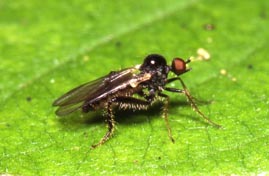 |
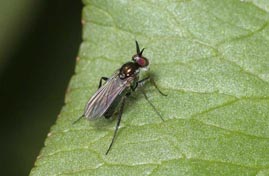 |
Hybos reversus Walker (photo by S.A. Marshall) |
Rhaphium
sp. |
Virtually all empidoid flies are predaceous as adults and larvae, mainly on other insects. There are very few empidoid groups that are exceptions to this predaceous habit, but Iteaphila Zetterstedt, Anthepiscopus Becker, Anthalia Zetterstedt, Allanthalia Melander and Euthyneura Macquart appear to be obligatory pollen feeders as adults, and species of Thrypticus Gerstäcker are known to have phytophagous stem-mining larvae. Empidoids primarily occupy various terrestrial habitats such as forests, open woodlands, grasslands, and agricultural areas, but some groups have truly aquatic larvae and are associated with various wetland habitats. Predaceous empidoid flies are important natural and biological control agents of various pest insect species precisely because of the wide range of habitats occupied and their vast species diversity.
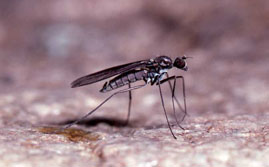 |
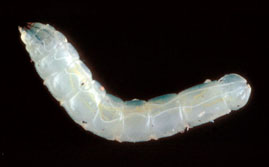 |
| Clinocera fuscipennis
Loew (photo by S.A. Marshall) |
Medetera
larva |
The Empidoidea have traditionally been divided into two families, the Empididae and Dolichopodidae, but recognition that the former family is not a natural or monophyletic group (Chvála 1983; Cumming et al. 1995) has led to differing classifications that split the “Empididae” into several families (Chvála 1983; Sinclair and Cumming 2006). For North America, keys to the genera of “Empididae” can be found in Steyskal and Knutson (1981) and Cumming and Sinclair (in press), whereas keys to the genera of Dolichopodidae can be found in Robinson and Vockeroth (1981) and Bickel (in press). Empidoid flies are not very well known at the species level for the Nearctic Region, because many genera require revision and few keys are available to distinguish species. Consequently, species identifications frequently depend on comparisons by specialists, of unidentified specimens with previously identified museum specimens.
References
Bickel, D.J. (in press) Family Dolichopodidae. In Brown, B.V., Borkent, A., Wood, D.M. and Zumbado, M. (eds.), Manual of Central American Diptera.
Chvála, M. 1983. The Empidoidea (Diptera) of Fennoscandia and Denmark. II. General Part. The families Hybotidae, Atelestidae and Microphoridae. Fauna Entomologica Scandinavica 12:1–279.
Cumming, J.M. and Sinclair, B.J. (in press) Family Empididae. In Brown, B.V., Borkent, A., Wood, D.M. and Zumbado, M. (eds.), Manual of Central American Diptera.
Cumming, J.M., Sinclair B.J. and Wood, D.M. 1995. Homology and phylogenetic implications of male genitalia in Diptera – Eremoneura. Entomologica Scandinavica 26: 121–151.
Robinson, H. and Vockeroth, J.R. 1981. Chapter 48. Dolichopodidae. Pp. 625-639 in McAlpine, J.F., et al. (eds.), Manual of Nearctic Diptera. Volume 1. Agriculture Canada Monograph 27: vi + 1-674.
Sinclair, B.J. and Cumming, J.M. 2006. The morphology, higher-level phylogeny and classification of the Empidoidea. Zootaxa 1180:1-172. PDF document
Steyskal, G.C and Knutson, L.V. 1981. Chapter 47. Empididae. Pp. 607–624 in McAlpine, J.F., et al. (eds.), Manual of Nearctic Diptera. Volume 1. Agriculture Canada Monograph 27: vi + 1-674.
First published on the Internet on 18 November 2005
Last update: 26 May, 2006
J.M. Cumming
